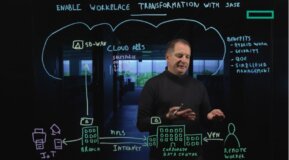
Over the last few years, we have all heard the terms 'hotspot,' 'Hotspot 2.0,' and 'cellular offload.' But what exactly does it all mean? What can all of this do for users?
In this blog series on Passpoint, I will explain what Passpoint is, how carriers are implementing it, what advantages it can provide to enterprises and where can we go from here. In part one, we will begin by discovering what Passpoint actually is.
Cellular devices are multiplying faster in the world today than the human population. According to research from Statista, by 2023 there will be 16.8 billion cellular devices in the world.
As the number of cellular devices grows, carriers have begun to have issues providing service to these devices. Just as in wireless LANs, there is only so much spectrum that can be used by devices communicating wirelessly. The question became, how can cellular providers offload some of this load from their networks?
For the last 20 years or so, wireless LANs have become more prevalent in the marketplace. The majority of stores, restaurants and public venues provide some sort of wireless network for guests and customers to connect to. As these networks have grown in number and availability, users have begun offloading their cellular devices to these wireless LANs. This ‘offloading’ is exactly what the cellular providers have been looking for to help alleviate the growing number of devices on their networks and to free up spectrum and bandwidth. However, the process was cumbersome for users. Let’s use Starbucks as an easy example.
I am sure most of us have spent some time in a Starbucks as a customer and connected a phone or other device to the wireless. If you are connecting your phone, what is the process? You have to go into the store, open your settings, find the network, join it and go through the authentication process. You are now offloaded from the cellular network, but it was not very easy. That network will be remembered on your device the next time you join, but it was kind of a pain to get it set up the first time. What if there was an easier way? This is where Passpoint or HotSpot 2.0 comes in.
Passpoint, as it is implemented today, allows cellular users to connect to Wi-Fi networks with credentials provided by the carrier to allow Wi-Fi Calling as well as offloading the user’s data to a Wi-Fi network without having user intervention to connect. In this implementation of Passpoint, users are effectively still on the cellular network from their vantage point even though the data has been offloaded to the Wi-Fi network. This allows the cellular carriers the relief in spectrum and bandwidth they need and allows connectivity at locations with large numbers of users, such as sports venues, large public venues, and even enterprise locations.
Aruba Networks has a history of successfully implementing Passpoint in numerous locations such as its corporate headquarters and the Atmosphere conference. The functionality of Passpoint and how is it deployed will be covered in the next few posts in this series, but a good overview of Passpoint and how it is used within an Aruba network infrastructure can be found here and will be referenced in upcoming posts on how Passpoint is implemented, advantages of Passpoint, as well as how it can be used in enterprise networks.
Related Content
Whitepaper: Solving the Indoor Wireless Coverage Problem: Passpoint and Wi-Fi Calling





